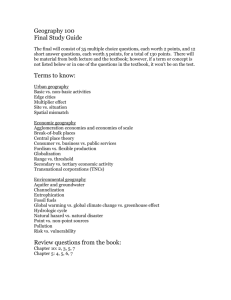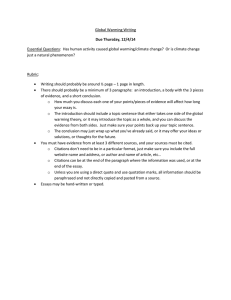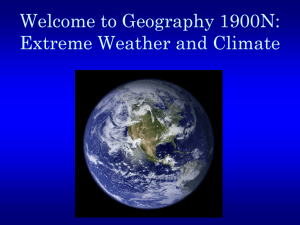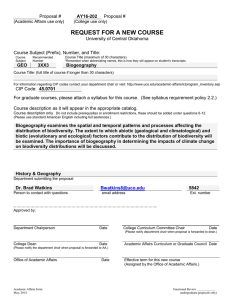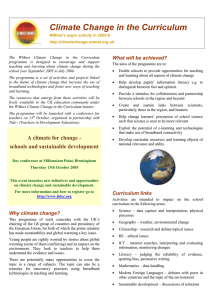Study guide for final
advertisement
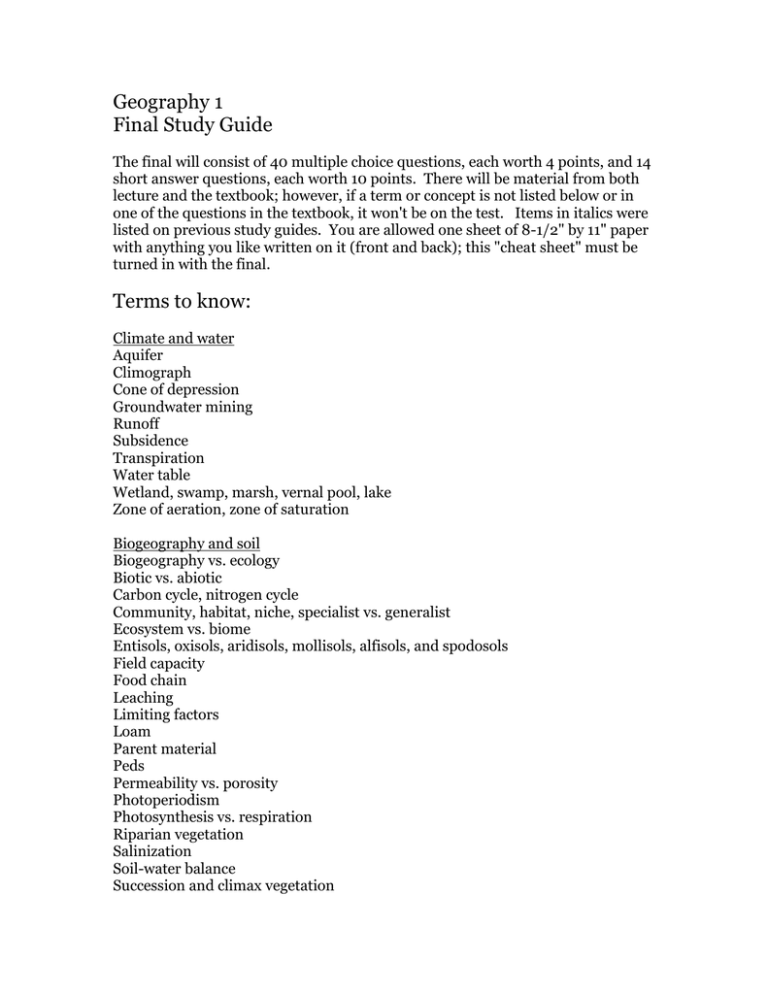
Geography 1 Final Study Guide The final will consist of 40 multiple choice questions, each worth 4 points, and 14 short answer questions, each worth 10 points. There will be material from both lecture and the textbook; however, if a term or concept is not listed below or in one of the questions in the textbook, it won't be on the test. Items in italics were listed on previous study guides. You are allowed one sheet of 8-1/2" by 11" paper with anything you like written on it (front and back); this "cheat sheet" must be turned in with the final. Terms to know: Climate and water Aquifer Climograph Cone of depression Groundwater mining Runoff Subsidence Transpiration Water table Wetland, swamp, marsh, vernal pool, lake Zone of aeration, zone of saturation Biogeography and soil Biogeography vs. ecology Biotic vs. abiotic Carbon cycle, nitrogen cycle Community, habitat, niche, specialist vs. generalist Ecosystem vs. biome Entisols, oxisols, aridisols, mollisols, alfisols, and spodosols Field capacity Food chain Leaching Limiting factors Loam Parent material Peds Permeability vs. porosity Photoperiodism Photosynthesis vs. respiration Riparian vegetation Salinization Soil-water balance Succession and climax vegetation Symbiosis Vertical zonation Xerophytic Natural disasters and climate change Greenhouse effect vs. global warming vs. global climate change Risk vs. vulnerability From previous chapters Adiabatic cooling and warming Albedo Angle of incidence and path length Condensation vs. evaporation Continental vs. maritime climates Convergence (3 types) vs. divergence vs. transform Coriolis effect Erosion, transport, and deposition Igneous vs. sedimentary vs. metamorphic Insolation Inversion Isolines (including isotherms, isohyets, and isobars) ITCZ Large-scale vs. small-scale maps Latent heat Latitude vs. longitude; parallels vs. meridians Mechanical vs. chemical weathering Monsoon Saturation Stable vs. unstable vs. conditionally unstable air Tsunami Review questions from the book: Chapter 6: 3 Chapter 8: 4-8, 10-11 Chapter 9: 1, 3, 6, 9, 11-12 Chapter 10: 1-2, 7-9 Chapter 11: 1-3, 5-7, 9-11 Chapter 12: 2, 4, 6, 8, 9, 11, 15 Chapter 19: 1-2, 14 Chapter 3: 5-7, 11 Chapter 4: 7, 10-12, 16-17 Chapter 5: 10, 16, 18 Chapter 6: 1, 10, 16, 18 Chapter 14: 4-6, 9, 14 Chapter 15: 1, 5 Chapter 18: 1-2, 4, 9 Other things to know: 1) Any of the "25 questions you should know about physical geography" 2) What are the characteristics of the plants and animals of each of the 11 major biomes, and where are they likely to be found? 3) Give at least two reasons why: Property damage from natural hazards is higher in developed countries. Loss of life from natural hazards is almost exclusively in developing countries. 4) How confident are scientists that global warming is occurring because of human activity, and how do they know? 5) What are some of the implications of global warming for the weather, the oceans, and ecosystems? 6) What are the two main ways we define geography? 7) Explain how the roundness and tilt of the earth create seasons.
